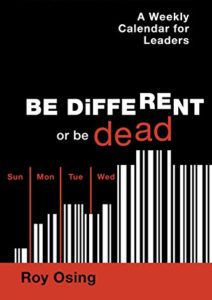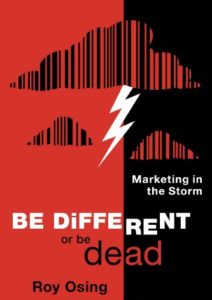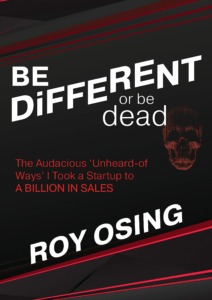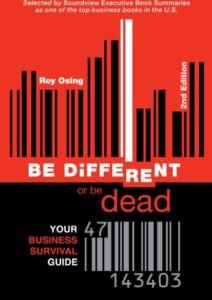What are they really afraid of — your truth or their truth? It’s definitely a combination of both: what they see you doing in the market and what they observe when they examine their own plans and strategies.
But in the final analysis, it’s THEIR truth that scares them the most because that’s all they can control; they have no control over what you do. They see their strategy and capabilities and judge their worth relative to yours.
And even though they may see a gap, they struggle to do anything about it.
And that’s the truly scariest thing.
This is your competitor’s “fright nirvana”; their perfect storm.
What is your truth?
You deliver what people desire
Your value proposition addresses a compelling customer want or desire rather than a customer need.
Offering what people covet or “lust for” attracts more attention and market advantage than simply providing a needs-based solution. There is a huge emotional component in the decision to buy what we crave — a Maui vacation — that is absent when we buy what we need — milk; as a result needs driven competition is highly price sensitive and the market tends to be a commodity in status.
Organizations that choose to create emotional draw should be feared, for they will be around for a long time.
You talk to individual people
You target specific customer groups with high revenue potential rather than the general mass market; as a result, your efforts have a laser-like focus that produces an extremely high success rate, unlike others who dilute their efforts across many market segments. Spraying your marketing message across a broad market hoping it will resonate with someone who will be persuaded to buy is a high risk — low payback tactic practiced by those who don’t understand marketing.
You are the only one
You differentiate yourself from others in the market by being “the only one that…” Your claim is simple, understandable and believable by those listening. Competitors that try and carve out a competitive position that relies on being “the best”, “number 1” or “market leader” have vague competitive claims. They are overused and are not credible as they can’t be proven — who says you’re best and why should I believe them?
You build deep relationships
You don’t sell, but concentrate your efforts on building deep intimate relationships with your customers, trusting that the power of the relationship will motivate the buying decision. You are in the one-of-a-kind class with this approach.
Your marketing plan is to create integrated value-based packages for discrete high potential customer groups, which serves two ends: first, packages respond a broad set of customer requirements and therefore have a greater appeal factor than solutions that are narrow in their coverage and second, packages are extremely difficult for competitors to copy. Integration of the functionality required to deliver a package often involves systems and operations capabilities which don’t lend themselves easily for a competitor to provide.
You focus on execution
You place a relentless focus on strategy execution. Leadership understands that a brilliant plan without pristine execution is worthless. You work hard to get your plan “just about right”, and spend copious time determining how to execute it flawlessly.
An expression of this is your leaders’ support of frontline teams; those people who serve customers and who own the company’s brand. They are considered to be the most important people in the organization and are so served by “How can I help?” leaders.
To be enamored by planning would only conjure up a condescending grin from your competition.
What is their truth?
They slash prices
They rely on having low prices as the way to attract business; their margins are skinny margins as price competition is a race to the bottom. Their unwillingness to create value as the way to long-term sustainability makes them second rate and holds them back; they know it but can’t make the change.
They flog products
Their sales thrust is pushing products; trying to make people comply with and accept what they supply. Failure to respond to what customers are asking for — and keeping pace with how their demands change over time — is a short-term myopic view at best and will never succeed in the long term. Product pushing strategies come from poor leadership; nothing changes until leaders change and in the meantime, there is a collective fear in the sales force.
They are copycats
They use benchmarking as their source of innovation and at best have the potential to achieve operational improvements but will see no change to their strategic position. Copying others occasionally changes their position in the herd of competitors but it never places them above it in a unique position. In many cases the reliance on best practices is the only way they can innovate; they don’t have an innovative culture. They know this but are trapped; it keeps them awake at night.
They lack servant leadership
They lack “loved leadership” and lack strong employee engagement. People are not all that committed to pitching in to help the organization achieve its strategic intent. Traditional leaders populate executive and management ranks. Expression and creativity are honored in name only. Funny, this fright to most is subliminal; they don’t even know it’s missing.
They manage costs
They treat cost management as a high priority; managing costs down to preserve acceptable margins is their main emphasis. They outsource operating functions whenever they can to control costs — for example call centers and receivables management are examples — and they develop Internal systems and operating procedures with low cost as the main acceptance criteria. This approach often leads to dissatisfied customers who aren’t happy to engage with the organization the way it wants.
They are dysfunctional internally
They wage “internal war” constantly, arguing over priorities and generally causing dysfunction that takes their eye off what they are trying to achieve in the market. Their dysfunction compared to your internal harmony makes their fear factor soar.
A competitor’s fright factor largely depends on their own limitations when they compare themselves to others in the market and are magnified when you are doing the right things.



















Comments